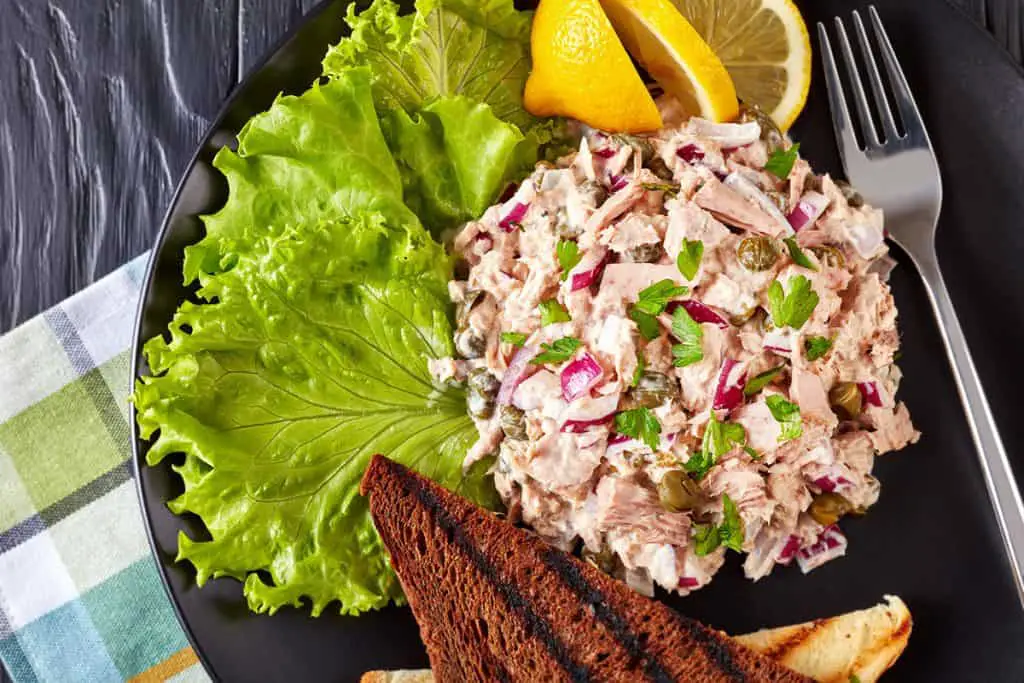The Right Way to Freeze Tuna Salad (Explained)
Tuna salad is a very versatile dish. You can use it as a simple sandwich spread or a side dish for your next meal. Many people make extra amounts to store for easy access later, but can you freeze tuna salad?
You can freeze tuna salad, but it’s not recommended. Mayonnaise, a prominent ingredient in tuna salad, separates when you freeze it. This affects the salad’s texture and quality. It would be a much better idea to freeze just the tuna itself and add the other ingredients once thawed.
This article explains what exactly happens when you freeze your tuna salad, offers food safety reminders, and tips on how to properly handle this particular food.

What Happens When You Freeze Tuna Salad?
Tuna salad can become unappetizing when you freeze it. Mayonnaise separates when frozen and cannot be mixed back together when thawed. Vegetables used to add some crunch to the salad have moisture that turns into ice crystals. This makes the greens turn into mush when they are unfrozen.
General Guidelines on the Shelf Life of Tuna Salad
Tuna salad has varied recipes, including different ingredients that can affect how long they stay good to eat. However, the USDA has given these general guidelines for the shelf life of cold perishable foods, including salads:
- At room temperature: If the room temperature is below 90 °F (32 °C), food can last up to 2 hours, and just 1 hour if warmer than 90 °F (32 °C).
- In the fridge: Tuna salad can last up to 3-5 days in the refrigerator.
- In the freezer: When properly stored, tuna salad can have a shelf life of up to 2 months.
How To Properly Freeze Tuna Salad (For Best Taste)
Storing tuna salad in the freezer is only applicable for low-mayonnaise recipes. Creamier salads shouldn’t be frozen because the dish’s quality is sacrificed if the mayo separates due to freezing. This is why refrigeration is the best way to store your salad while keeping its quality.
However, here are some tips to keep in mind if you want to properly freeze your tuna salad:
- Drain water-stored tuna. Your goal is to remove as much water from your tuna as possible. The drier it is, the better it stores in the freezer.
- Use Miracle Whip instead of mayo. Mayonnaise breaks down and separates when frozen. Miracle Whip does not and is freezer-friendly.
- Store toppings and sides separately. Only add them to your tuna salad right before you’re about to eat it.
- Don’t add any moisture-filled vegetables. This includes salad greens, celery, and onions. They usually provide crunch to your salad, but freezing these salad items turns them into limp mush.
- Divide your salad into smaller portions to freeze. Having several smaller packs or containers of salad is more manageable. This way, you get to thaw only the amount you plan to eat. Smaller packages also freeze better. Amazon offers these Ziploc Freezer Quart Slider Bags you can use. They’re strong and durable and will keep your tuna salad well-protected.
- Use an air-tight container. You can use freezer bags or containers with lids. You can also add an extra layer of plastic under the cover to keep moisture and air out. Another option is to use freezer tape (Amazon) to seal your container. A great container are the Rubbermaid Brilliance Leak-Proof Food Storage Containers from Amazon. The leakproof containers feature an airtight seal to prevent spills or leaks, keeping your salad fresh.
- Store the container with ½ inch (1 cm) between the salad and lid. This space is needed because tuna salad expands when frozen.
- Clearly label each container. Mark each container with the name and date it was prepared and stored. This ensures that you don’t end up eating old tuna salad. Amazon has easy to use Duck Brand Write-On Freezer Tape that you can use for your labels. They’re also white in color, making it easy for you to read the labels.
- Store the container on a freezer shelf. Don’t place it in the pockets on the door. Salad needs to be stored at a constantly cold temperature to stay well-preserved. The door pocket storage may not have a stable cold temperature due to the constant opening and closing of the fridge or freezer.

How To Use Tuna Salad From the Fridge or Freezer
- Refrigerated. You can use tuna salad straight from the refrigerator, though it might be a bit cold. If you want, you can warm up the salad by taking the container out of the fridge and letting it sit for a few minutes.
- Frozen. Take the tuna salad out from the freezer a day before you plan to consume it, then put the container in the fridge to thaw. You can also place the container in a bowl of water in the refrigerator to speed up the process.
How To Tell if Your Tuna Salad Has Gone Bad
Eating spoiled tuna salad can cause headaches, diarrhea, and nausea. So you should always check if your tuna salad is still good. Don’t try to give it a taste test!

Here are other signs you can watch out for:
- Your salad shouldn’t be extra watery. Some moisture is expected from the tuna, vegetables, and other ingredients. However, if your salad is extra watery, it’s best to throw it out.
- Sour smell. When you open your container and get a whiff of something sour or off, your tuna salad is most likely inedible.
- Change in appearance. If your salad’s color is off, or you can see mold, it’s definitely spoiled.
Foods That Aren’t Freezer-Friendly
When you freeze most foods at a constant temperature of 0 °F (-18 °C), they’ll stay preserved almost indefinitely if packed well. The thing is, though the food stays safe, the quality can go down the longer it stays in the freezer.
Here are some foods that are best not stored in the freezer:
- Water-rich produce, salad greens, herbs. These foods become limp and turn into a mushy mess after they are frozen.
- Eggs. Boiled or not, if these are in the shell, they expand when frozen. This can cause the shell to crack and let bacteria in. Cooked egg whites also turn rubbery.
- Carbonated drinks. Soda, beer, and the like should never be put in the freezer. Sure, maybe you can cool your drinks faster, but forget them in there, and the can or bottle will explode all over your freezer.
- Spices and seasoning. Their flavors change, or they lose their potency if put in the freezer.
- Potatoes. Freezing separates the potato’s moisture and starch, turning it into a crumbly mess.
- Cooked pasta and rice. These turn soggy upon defrosting.
- Dairy products. Most curdle, separate, or become watery when they’re frozen. Products like cheeses tend to become grainy.
Conclusion
Tuna salad can be stored in the freezer for up to two months if appropriately packed in an air-tight container. However, freezing can affect the salad’s quality, especially if it has a lot of mayonnaise.
The recommended storage method for tuna salad is refrigeration. Even though it has a shorter shelf life of about 3-5 days, the quality of the salad will be better.






